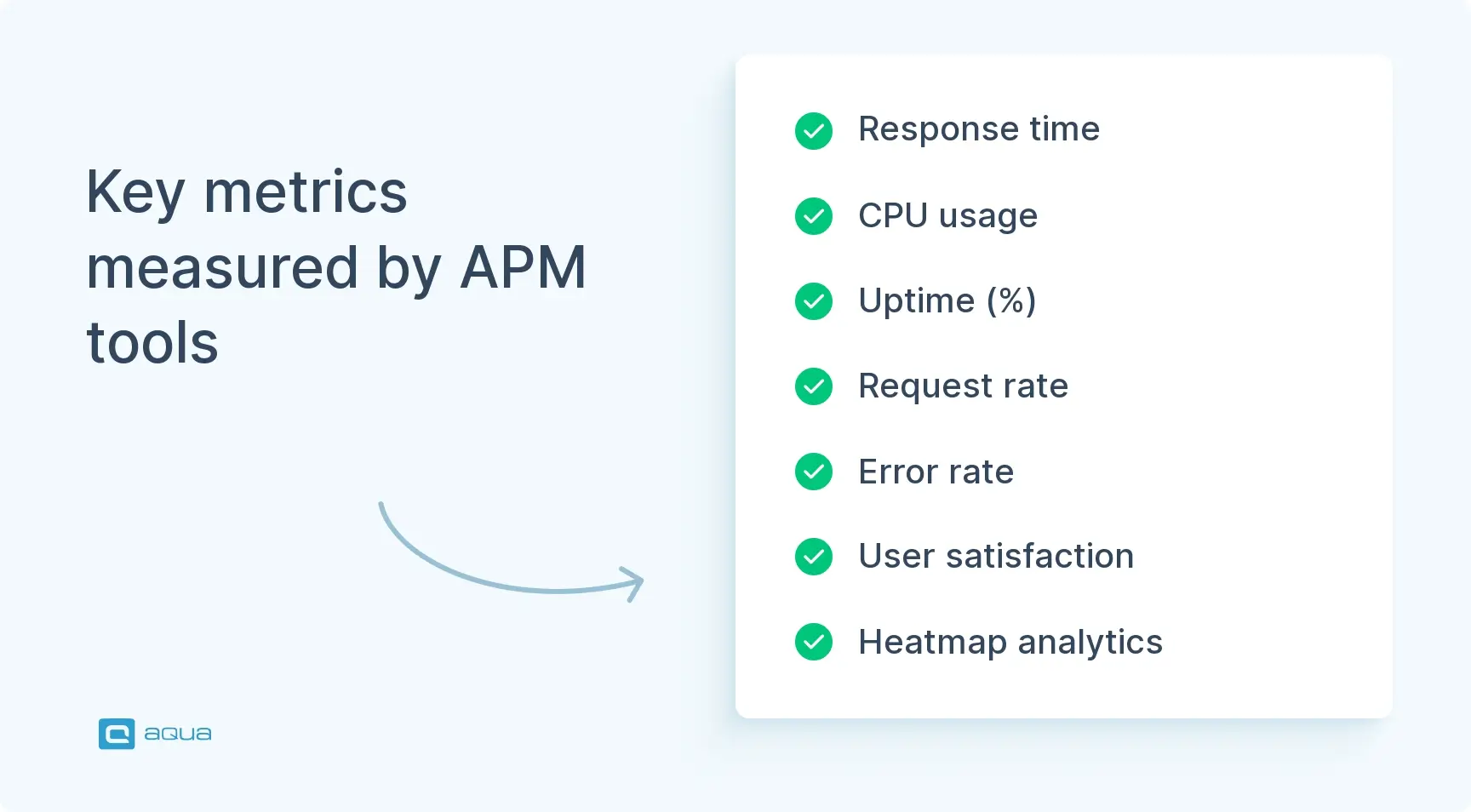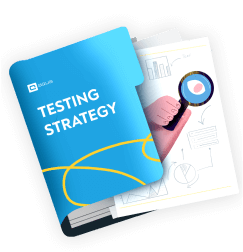Key Takeaways
- Application Performance Monitoring (APM) tracks both technical metrics and user behavior to verify software functionality and identify improvement opportunities.
- APM solutions measure critical metrics like response time, CPU usage, uptime percentage, request rate, error rate, and user satisfaction to ensure optimal performance.
- Gartner identifies five key APM components: end-user experience, runtime application architecture, user-defined transaction profiling, component monitoring, and analytics/reporting.
- APM utilizes three types of data: metrics (numerical status indicators), traces (individual user journeys), and logs (automated records of user behavior and app events).
- Successful APM implementation requires selecting the right tool for your programming languages, establishing clear performance benchmarks, and ensuring cross-department adoption.
Without proper performance monitoring, you won’t know if your app crashes during traffic spikes or if users abandon purchases due to new surcharges. Learn how to implement effective APM to protect your bottom line 👇
Purpose of application performance monitoring

The main purpose of APM monitoring is simple: you use the scientific method to see if your solution works.
Modern commerce is increasingly done online, meaning APM is what makes or breaks the bottom line. A good example here would be the food delivery service Glovo. Here’s what they do when they enter a new market:
- Launch restaurant and grocery delivery at a subsidised rate
- Use local pricing and early order analytics to define minimum order value
- Introduce a free delivery subscription to secure recurring revenue
- Stop subsidising delivery fees
- Raise delivery fees and minimum order value as bearable by customers
All these decisions help Glovo offset the thin and negative margins common for lifestyle-altering tech companies. All these decisions would not be possible without a solid application performance monitoring process. You need to know that your users decide not to order their favourite taco exactly the moment they see a new surcharge.
Your monitoring strategy directly impacts revenue – and here’s why that matters more than you think. Today’s APM tools track the entire journey: from that split-second when users click your app to the complex dance happening across your microservices and serverless functions.
Glovo is once again a good example here. In April 2022, some sort of a caching problem or backend error made item cards load for up to several minutes at a time. Good performance monitoring alongside modern SaaS software testing helps spot such problems and solve them before too many users leave for an alternative app.
What do APM solutions and tools measure?
Now that we have looked at the definition and business value of APM, let’s see what metrics are commonly tracked by the best APM software.
- Response time demonstrates how long it takes for a user to see their action reflected on the app
- CPU usage refers to the load on your server: the app will slow down and malfunction if it is too high
- Uptime (%) illustrates the availability of your app. Most companies secured by a solid online test management tool use Continuous Delivery to be as close to the uptime of 100% as possible
- Request rate provides a traffic measurement that can be used to prepare for spikes in user activity and spot sudden drops early
- Error rate refers to how often the app degrades or fails due to software errors
- User satisfaction is customer satisfaction in numbers
- Analytics & heatmaps are also often considered part of APM


Get a testing strategy template that enables us to release 2 times faster
Components of APM
The renowned research firm Gartner provides five main components of application performance monitoring.
- End-user experience collects and processes performance data to see issues and bottlenecks that conflict with system requirements. It is also useful for adjusting these requirements if things work well on the technical side, but users won’t sign up / pay. Experts usually combine using bots to automatically go through the app and reviewing how the same steps went for real users.
- Runtime application architecture covers hardware and software components as well as their interaction. Your engineers can automatically spot anomalies to recognise costly issues early.
- User-defined transaction profiling further explores the actual customer experience. It reproduces specific actions that lead to a performance issue so the cause can be isolated and resolved.
- Component monitoring gives extra insight into the state of individual components observed in runtime application architecture monitoring. It lets you know when some server is out of order or is perhaps missing a critical operating system update.
- Analytics & reporting give your marketing, sales, product, and management people actionable insights to achieve or increase financial success.

Observability and APM: A Modern Approach
Traditional APM served us well, but observability? That’s where things get interesting. You’re not just tracking metrics anymore – you’re connecting logs, metrics, and traces to actually understand what’s happening under the hood. Think of it this way: monitoring tells you something broke. Observability tells you why.
When your distributed app starts acting up across multiple cloud environments, observability lets you trace a single user request through every microservice it touches. No more guessing games.
Instrument one critical user journey end-to-end. Pick your checkout flow or login process – something that matters to your bottom line.
This way, you catch problems before they become outages. Your team shifts from reactive firefighting to proactive optimization.
Do you work in a BFSI company?
Application performance monitoring process
Application performance monitoring utilises three types of data:
- Metrics, the numbers that provide status and can be used for insights
- Trace, a single user’s journey through the entire app
- Logs, automatically generated lightweight files that store information about user behaviour and app events
These days, the actual process is very straightforward. You simply purchase an all-in-one application performance monitoring tool and let your talented engineers do the magic. Google, Microsoft, and Dell all have their APM solutions, and there are also some specialised players in this field like Red Hat and Splunk.
Integrating APM with Testing and CI/CD
The smartest teams right now are weaving APM directly into their testing workflows and it’s paying off big time. Instead of treating performance monitoring as an afterthought, you’re capturing baseline metrics during development and tracking how each code change impacts your app’s speed and stability.
You need to set up automated performance gates in your CI/CD pipeline that’ll block any deployment if response times jump more than 20% from your baseline.
Your developers start thinking like performance engineers from day one, since they get immediate feedback on how their code performs under real conditions. Start by adding one simple performance assertion to your existing test suite – something like ‘API response under 200ms’ – and build from there.
Tips for APM success
Here are some ideas to make the most out of application performance monitoring.
- Pick the right tool. The main requirements are: fits your programming languages, has business insights-oriented architecture, and leverages predictive analytics. You should regularly check which tools use the best players in your industry. If you work in finance, our list of testing tools for the banking sector will show you the most popular options.
- Know your benchmarks. There is no use in predictive analytics spotting abnormal behaviour unless you define normal. Server load, bounce rate, and response time all need a value that your APM will be monitoring against.
- Get everyone on board. Ideally, it should not just be your engineers and the people who requested APM that work with it. If it was the product team that wanted it, make sure to show its value to upper management (and vice versa). Content people can find some exciting insights as well.
Conclusion
Application performance monitoring is a powerful tool. It can be used to grow your business, protect the company against costly mistakes, and optimise costs. If you are not using an APM yet, we recommend that you find one.
Just monitoring performance, however, won’t cut it. It’s performance testing that gets you the app looking all green in an APM tool. Performance testing helps you imitate different loads on the app to see if it remains fast, reliable, or at the very least functioning. It is especially important for B2C companies, where the nature of social media and/or seasonality can mean a huge uptick in customers. It would be very unfortunate if your app couldn’t handle the fame.
aqua is designed with performance testing in mind. We have integrations with the leading automated performance testing tools, such as JMeter and Selenium. You can also connect any other tool via REST API. aqua is an Application Lifecycle Management solution that can be used for not just testing, but defect management and software development as well.
Try aqua yourself — 30-day trial


















